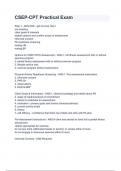Interview
Class notes Life Sciences: Nucleic Acid and DNA-RNA Replication
- Course
- Institution
This paper encompasses detailed class notes on Nucleic Acid, The difference between DNA and RNA, functions of the nucleus, types of nucleic acids, chemical structure of RNA and DNA, types of RNA and DNA, Replication of RNA and DNA, DNA sequences in chromosomes, DNA molecule, High order DNA structu...
[Show more]




